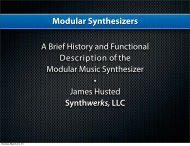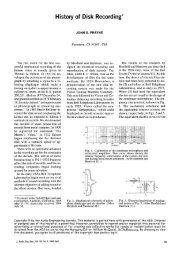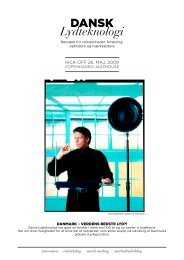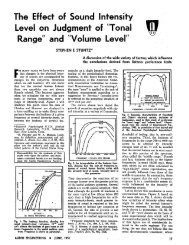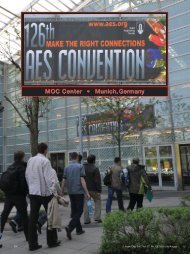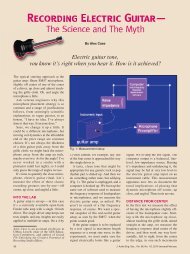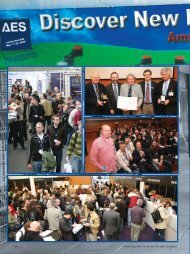[History of] Motion Picture Sound Recording - Audio Engineering ...
[History of] Motion Picture Sound Recording - Audio Engineering ...
[History of] Motion Picture Sound Recording - Audio Engineering ...
You also want an ePaper? Increase the reach of your titles
YUMPU automatically turns print PDFs into web optimized ePapers that Google loves.
straight-line portion <strong>of</strong> the negative H & D curve, the print The negative track is recorded on a high gamma positive<br />
being made on the straight-line portion <strong>of</strong> the print H & D type film in contrast to a low negative gamma film for the<br />
curve. Light valve recording followed the basic principles variable-density method. Since the major studios had al<strong>of</strong><br />
rendering tone values laid down by L. A. Jones <strong>of</strong> ready installed the ERPI variable-density system, RCA<br />
Eastman Kodak Co. [5]. An excellent analysis <strong>of</strong> straight bought up RKO <strong>Picture</strong>s and installed its variable-area<br />
line and toe records was made by Mackenzie [6] in 1931 system, a refinement <strong>of</strong> General Electric's earlier efforts<br />
and shown in Fig. 4. [7]. Walt Disney Studioslater adopted the RCA system.<br />
While the variable-density systems were being intro- After that, variable density dominated the industry until the<br />
duced into the motion picture industry, another type <strong>of</strong> mid-Forties, when the variable-ama method became more<br />
track, now known as variable area, was being developed. In popular. Almost every motion picture studio now uses<br />
variable area recording.<br />
I \ ' _ I ',, I i , I<br />
PRINTER H &D CURVES _ I OVERALL HLD CURVES<br />
/3 _Z_,_o - '--i _i_
" [ / I I Inspite<strong>of</strong>theseimprovements, signal-to-noiseratioin<br />
photographic sound tracks stayed around 50 dBfor newly-<br />
': V_ __ _ [ __ _~_5r,,i_ , processed phonic sound variable-area was recordedlive prints. After in 1933,Bell three-channel Telephone stereo-<br />
xx_"i- X",[_>o,/, / __ Laboratories began working to put a similar effect on film<br />
_- i', [ _,_' I phonyorchestrawitha range<strong>of</strong> 80dB ona mediumwhose<br />
i Lx_,, I_',, l_r_-t' I_._ ?-_- I range [12].Sincetheengineerswantedto was about 50 dB, they had to record recorda the top largesym- 30 dB at<br />
constantmodulation<strong>of</strong>thefilm(Fig.10).Inreproduction,<br />
17 1 -<br />
:: It<br />
o.,' P ...... A / _ ' I<br />
Fig. 7. Intermodulation obtained from single and push-pull _ 20 _,c,_ /<br />
tracks ,o r/_......... ",, __/ ,_D ............ ,o,sE /<br />
t LEVEL .___....i./<br />
I0 20 30 40 5D eO 70 eO 0 10 20 .30 4O _O eo 70 8o<br />
various expoures, developing to various gammas and print-<br />
SOUND LEVEL IN DECIBELS<br />
(,)<br />
AMPLIFI£R OUTPUT IN<br />
(b)<br />
DECIBELS<br />
ing at various exposures. Families <strong>of</strong> curves are shown in Fig. 10. Noise reduction in film, ca. 1933: relationship between<br />
Figs. 6 and 7, giving the lowest values <strong>of</strong>the 60 Hz tone and a) amplifier ga{n and light modulation to sound level and b)<br />
indicating the correct processing parameters. About the photocell output and noise level to sound output in compandor<br />
same time, RCA developed the cross-modulation technique<br />
to indicate the correct processing <strong>of</strong> variable-area tracks for the gain <strong>of</strong> the amplifier system remains constant over the<br />
minimum rectification <strong>of</strong> zero-shift [11]. The curves in lower 50 dB, increasing 1 dB for each decibel <strong>of</strong> output up<br />
to the 80 dB level. The result is an effective 30 dB <strong>of</strong> noise<br />
reduction. In this compandor system, the amplified output<br />
t<br />
Oo/I f -, 7 , .<br />
' I __ tone is modulated by the signal envelope, the output being<br />
o&_ ' I [--I +1 _[____ [ <strong>of</strong> fedeach intothecontrolcircuit<strong>of</strong> microphone is bridged the to acompressor.Thecom- modulator in which a<br />
'_ i i--[-I I I--i ] I I I _ !_ bined output <strong>of</strong>the modulators <strong>of</strong> the three tones (250, 630<br />
"" ____' x_j x¢_.;/_/_<br />
;_','_ _'V
Studios tended to use 35 mm full-coated tape: they were<br />
- r-' .......<br />
____<br />
t' ' .......... " "1 '_<br />
fully-equipped with expensive 35 mm sprocket-type record-<br />
beganto usethe magneticmediumfor in-studiorecording.<br />
ers and reproducers, and synchronization <strong>of</strong> iA" tape with<br />
f ,E,,oDucE, } sprocket-type cameras and projectors was yet to come.<br />
i I.q5'4'<br />
I I I<br />
I<br />
z<br />
REI_ .007 _Et_<br />
Fig. 12. Schematic diagram <strong>of</strong> stereophonic reproducing chan- I I --i I o_z<br />
·o5o _[_.zot,Ii. . .//o<br />
nel rvP. 6 rt_cKS _ _ '4_<br />
-- _.4-g4<br />
this experimental work by the Bell Telephone Laboratories Fig. 13. Todd-AU 70 film coating, track layout<br />
was chiefly an attempt to achieve true acoustic perspective<br />
in reproducing what a listener would hear from the stage. CinemaScope, the brainchild <strong>of</strong> 20th Century-Fox, was<br />
the first serious attempt to introduce stereo into ordinary<br />
Fantasound release prints. It was combined with an anamorphic system<br />
" While Bell was working on compandor stereo, RCA <strong>of</strong> lenses on camera and projector to give the effect <strong>of</strong> a wide<br />
developed Fantasound, the system used in Fantasia, for screen. There were three stereo tracks and a narrower<br />
Walt Disney Studios [13]. The original recordings were control track (Fig. 14). The magnetic tracks were supermade<br />
with 8 push-pull variable-area channels. Six separate ss,_<br />
channelswere used for closeups <strong>of</strong> variousorchestral<br />
groups. A seventh channel recorded a combination <strong>of</strong> all f '_<br />
six, while an eighth recorded a distant pickup <strong>of</strong> the or- reAcgs reAcKs<br />
chestra. The Ave Maria number was later recorded with I 1. 4<br />
three channels. In re-recording, the original tracks were .o,o ./_o .e?8 _.,_ .o,o<br />
transferred to three channels. These, plus a control track, _ J_f---_'l _ _ i -' I'<br />
were made on a separate 35 mm film. The control track I lll<br />
contained frequencies <strong>of</strong> 250, 630 and 1600 Hz, which<br />
were used to enhance the limited volume range <strong>of</strong> the sound Eo_<br />
tracks. Fantasound differed from the Bell Telephone<br />
H<br />
GUIDED<br />
Laboratories system in that the latter was designed to pre- . M_fr_c:_:cl!_l_<br />
serve the acoustical perspective <strong>of</strong> the original orchestra, co_ _--_ -<br />
whereas Fantasia set out mainly to create effects that '_,i' , i , _mr<br />
reflected the mood <strong>of</strong> the animated pictures on the screen. It i i''°°_ . _7_, .o_e _1_..___ I._._ I_ ' i [ .o,az<br />
was the first film that used a surround system to enhance the .o_&__z__._ _ r"<br />
overall audience reaction. Fig. 14. Cinemascope:threestereotracksandcontroltrack<br />
While the Bell compandor stereo and Fantasound systems<br />
aroused interest in the motion picture industry, there imposed on the 35 mm film by a striping process. Cinemawas<br />
no immediate follow-up. The first commercial use <strong>of</strong> Scope was never very popular. For one thing, striping each<br />
stereo in the theatre was the Cinerama system. This used a individual release print was much more expensive than<br />
separate 35 mm magnetic-coated film carrying the stereo printing a photographic track. Magnetic tracks, either stanand<br />
surround tracks. It was followed by the successful dard or CinemaScope have, for all practical purposes, dis-<br />
Todd-AU 70 film carrying the picture and the coated appeared from the screen.<br />
magnetic tracks. This system employed five independent Since their demise, the industry has been working on a<br />
stereo tracks plus a control track, and used five loudspeaker compatible stereo system that uses the photographic<br />
systems behind the wide screen (Fig. 13). medium. As early as 1955, Frayne [14] demonstrated a -<br />
After World War II, and the success <strong>of</strong> the Ampex two-channel photo stereo release print which carried two ,<br />
magnetic tape developments, the motion picture industry separate tracks in the standard sound track position (Fig.<br />
JULY/AUGUST 1976, VOLUME 24, NUMBER 6 515
the use <strong>of</strong> a three-speaker system for reproducing music and<br />
.076 sound effects.<br />
An excellent paper on the Dolby system as applied to<br />
- ,?_43 _ tage optical <strong>of</strong>sound localizingdialog tracks appeared at centerscreenwhilepermitting<br />
in the September, 1975Journal<br />
<strong>of</strong> the SMPTE [17]. The author says that a flat recording<br />
and reproducing characteristic using the Dolby noise reducimproved<br />
high-frequency response with lower distortion.<br />
-i tionsystemgivesanimprovedsignal-to-noiseresponse,an<br />
He also claims that the print is compatible with unconverted<br />
t theatre playback equipment.<br />
The photographic medium is still a highly satisfactory<br />
_J and Adapting economicalway stereo to this to medium recordwill soundon probablyreleaseprints. guarantee its<br />
_-- continueduseinthefuture.<br />
I REFERENCES<br />
,/ [1] Tykocinski-Tykociner, J., "Photographic <strong>Recording</strong><br />
and Photo-Electric Reproduction <strong>of</strong> <strong>Sound</strong>," Transac-<br />
.036<br />
-<br />
.036<br />
tions <strong>of</strong> the SMPE, Vol. 6, p. 90 (May,<br />
[2] De Forest, L., "The Phon<strong>of</strong>ilm,"<br />
1923).<br />
Transactions <strong>of</strong><br />
the SMPE, Vol. 6, pp. 61-77 (May, 1923).<br />
o_9_a_ [3] Frederick, H. A., "Recent Advances in Wax Re-<br />
Fig. 15. Two-channel<br />
thor<br />
photo stereo print demonstrated by au- cording," Transactions<br />
(August, 1927).<br />
<strong>of</strong> the SMPE, Vol. 10, p. 294<br />
[4] Mackenzie, D., "<strong>Sound</strong> <strong>Recording</strong> with the Light<br />
Valve," Transactions <strong>of</strong> the SMPE, Vol. 12, p. 730 (Sep-<br />
1'5). Variable-area recording was employed, but the system tember, 1928).<br />
would work equally well with variable density. In this [5] Jones, L. A., "On the Theory <strong>of</strong> Tone Reproducdemonstration,<br />
the original recordings were made with a tion," Jour. Opt. Soc. Am., Vol. 4, p. 420 (1920).<br />
two-microphone channel system. A third channel was [6] Mackenzie, D., "Straight Line and Toe Records,"<br />
created by mixing the two channel outputs into a center SMPE Journal, Vol. 17, p. 172 (August, 1931).<br />
channel. On reproduction, a third channel was similarly<br />
created by combining outputs from the dual photocell. The<br />
[7] Dimmick, G. L., "The RCA <strong>Recording</strong> System,"<br />
SMPE Journal, Vol. 29, p. 28 (September, 1937).<br />
[8] Silent, H., and Frayne, J. G., "Western Electric<br />
result was a three-loudspeaker stereo system (Fig. 16). Noiseless <strong>Recording</strong>," SMPE Journal, Vol. 18, p. 551<br />
(May, 1932).<br />
g_,%}[° ........ [9] Silent, H., and Frayne, J. G., "Push-Pull <strong>Recording</strong><br />
......<br />
,__ _,,;3_ Lo_,<br />
{}QL with the Light Valve,"<br />
(July,1938).<br />
SMPE Journal, Vol. 31, p. 46<br />
,_;l;%i, I [10] Frayne, J. G., and Scoville, R. R., "Analysis and<br />
.2, ° '<br />
_°[_°D_ I<br />
II<br />
[.._; ,2_5:.o!__.?_ c<br />
;? -_-'t[L_j '<br />
Measurement <strong>of</strong> Distortion in Variable Density <strong>Recording</strong>,"<br />
SMPE Journal, Vol. 32, p. 648 (June, 1939).<br />
, ,I _! k : [11] Baker,J. O., andRobinson,D. H., "Modulated<br />
I_ _, _ o_,,_,_<br />
[}(]_ High-Frequency <strong>Recording</strong> as a Means <strong>of</strong> Determining<br />
Conditions for Optimal Processing," SMPE Journal, Vol.<br />
30, p. 3 (January, 1938).<br />
Fig. 16. Stereo reproducing channels for 2- and 2V2-channel [12] Steinberg, J. C., "The Stereophonic <strong>Sound</strong> Film<br />
systems System,"SMPE Journal, Vol. 37, p. 36 (October, 1941).<br />
[13] Garity, William E., and Hawkins, J. M. A., "Fantasound,"<br />
SMPE Journal, Vol. 37, p. 127 (August, 1941).<br />
Revival [14] Frayne, J. G., "A Compatible Stereophonic <strong>Sound</strong><br />
This system remained dormant until 1973, when R.E. System,"SMPTE Journal, Vol. 64, p. 303 (June, 1955).<br />
Uhlig described the use <strong>of</strong> the Dolby noise reduction system [15] Uhlig, Ronald E., "Stereophonic Photographic<br />
to enlarge the signal-to-noise ratio and thus overcome the <strong>Sound</strong> Tracks," SMPTE Journal, Vol. 82, p. 292 (April,<br />
loss in volume caused by the reduction in track width that 1973).<br />
the Frayne proposal made necessary [15]. The Dolby noise [16] Uhlig, Ronald E., "Two and Three Channel<br />
Stereophonic Photographic <strong>Sound</strong> Tracks for Theatres and<br />
reduction system, originally applied to magnetic tape Television," SMPTE Journal, Vol. 83, p. 729 (Septracks,<br />
applies equally well to optical tracks. In a later tember, 1974).<br />
paper, Uhlig proposed a further improvement for the [17] Allen, I., "The Production <strong>of</strong> Wide-Range,<br />
photographic stereo system: a phantom third track was Low-Distortion Optical <strong>Sound</strong> Tracks Utilizing the Dolby<br />
incorporated by combining the output <strong>of</strong> the two tracks and Noise Reduction System," SMPTE Journal, Vol. 85, p.<br />
feeding it to a central loudspeaker [16]. This has the advan- 720 (September, 1975).<br />
516 JOURNAL OF THE AUDIO ENGINEERING SOCIETY


![[History of] Motion Picture Sound Recording - Audio Engineering ...](https://img.yumpu.com/7927243/1/500x640/history-of-motion-picture-sound-recording-audio-engineering-.jpg)
